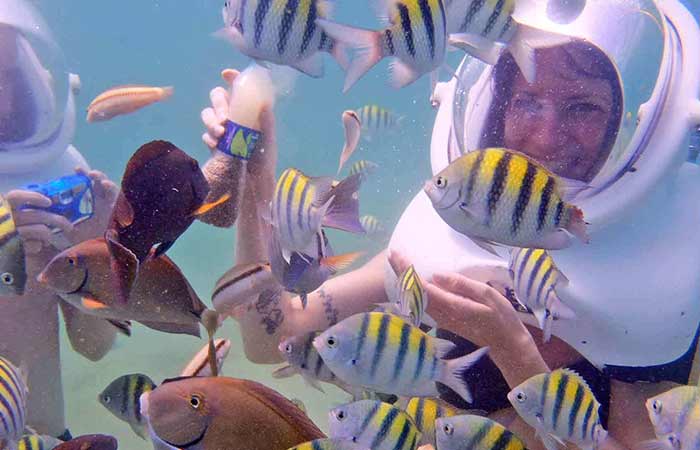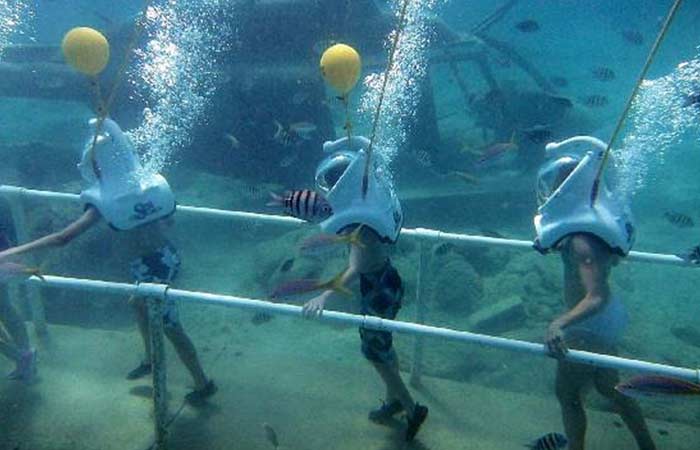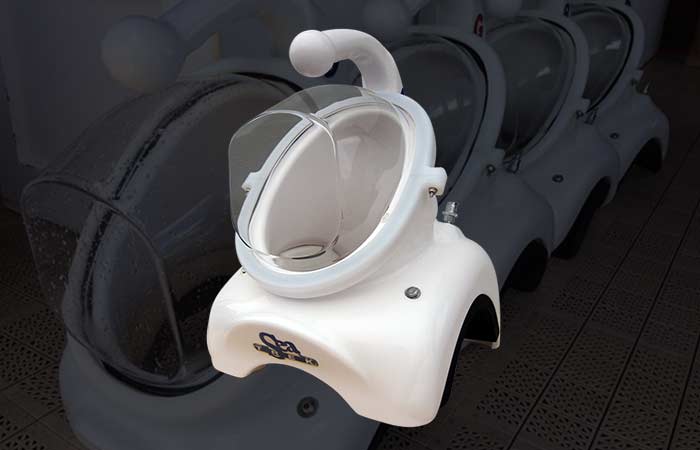Helmet Diving: All You Need to Know
Imagine being able to explore the spectacular beauty of the ocean’s marine life up close while breathing naturally, without any complex equipment or training. In that case, you should definitely try helmet diving.
This unique activity enables you to walk on the ocean floor while breathing normally and interacting with colorful fish and other marine creatures. So why not give it a try and discover the magic of helmet diving for yourself?
This article covers all you need to know about helmet diving, from equipment to safety measures, to help you make the most of this thrilling activity.
What is Helmet Diving?
Hamlet diving is a unique underwater experience that allows you to walk on the seafloor wearing a specially designed helmet. The helmet is connected to an air supply on the water’s surface via a hose, ensuring you can breathe effortlessly and naturally while enjoying the beautiful marine life around you.
The real magic of helmet diving is your closeness with the fish. They’ll come right up to you, curious and unafraid. You’ll feel like you’re a part of their community, swimming alongside them as if you were one of their own.
Another delightful aspect of helmet diving is an activity that caters to everyone who can breathe and walk within the age range of 12 to 65 years. Therefore, you can enjoy a new adventure under the sea in a safe and comfortable environment when helmet diving, regardless of whether you are young or old.

You don’t need any previous diving experience or training, as the helmet will keep you breathing naturally and effortlessly underwater while you immerse yourself undersea.
How Does Helmet Diving Work?
When you arrive at the dive site, a trained guide briefly introduces the equipment and safety procedures. Then, the guide will fit you with a specially designed diving helmet that will sit on your shoulders and cover your head, allowing you to see clearly through the transparent faceplate.
The helmet is connected to a hose that supplies fresh air from a compressor on the boat. The air is continuously pumped into the helmet, providing a constant flow of oxygen that allows you to breathe normally while underwater.
Once you’re fully suited up with your helmet, you’ll walk down a ladder into the water with the help of your guide. As you descend, the pressure in your ears equalizes, like flying in an airplane or driving up a mountain.
When you reach the bottom, you can walk around on the ocean floor while your guide leads you on a tour of the underwater environment. The helmet allows you to breathe easily and comfortably without specialized training or experience.
You’ll see all sorts of marine life up close, from schools of colorful fish to curious sea turtles. Your guide will also highlight interesting undersea environment features, such as coral reefs, rock formations, and underwater caves.
Your guide will constantly communicate throughout the dive, ensuring you’re comfortable and safe. They’ll also be taking care of the technical aspects of the dive, such as monitoring the air supply and ensuring that you stay within the group.
When the dive is over, you’ll walk back up the ladder to the surface, feeling thrilled and full of the wonder of the incredible world you just explored.

Helmet Diving Equipment & Gear
The equipment you need for helmet diving includes a helmet with a transparent faceplate, a weighted belt, gloves, a wetsuit, a boat, a compressor, a dive flag, a communication system, and boots.
Let’s take a look at each one of them.
Helmet
The helmet in helmet diving is a unique type of diving helmet that allows divers to breathe underwater without wearing a traditional scuba tank.

Below are the types of helmets used in helmet diving:
- Open-circuit helmets provide fresh air from the surface compressor, releasing exhaled air into the water.
- Closed-circuit helmets recycle air that the diver is breathing, then remove CO2.
- Free-flow helmets are similar to open-circuit helmets.
- Lightweight helmets are more comfortable and less bulky than traditional helmets. They are made of plastic or carbon fiber.
Here are some of the structures and components that you might find in a helmet used for helmet diving:
- Faceplate – This is the clear window in the front of the helmet that allows the diver to see underwater. It is usually made of high-quality tempered glass that can withstand diving pressure.
- Air supply – The helmet is connected to an air supply that provides a continuous flow of air for the diver to breathe. The air supply may come from a compressor on the surface.
- Exhaust system – As the diver breathes in the helmet, carbon dioxide builds up, so there needs to be a way for it to escape. The exhaust system allows carbon dioxide to be released from the helmet.
- Neck dam – The neck dam is a flexible seal that helps to keep water out of the helmet. It fits snugly around the neck of the diver, creating a watertight seal.
Pros
- Allows for normal breathing. You don’t need a compressed air tank on your back or a regulator in your mouth.
- It provides a clear, unobstructed view of the underwater environment.
- It makes it easier to communicate with other divers.
Cons
- The helmet can be heavy, making it more challenging to move around underwater.
- The helmet limits head and neck movement, making it harder to explore.
- The helmet is not as streamlined as other diving gear, so it can create more drag and resistance in the water.
Weighted Belt
A weighted belt is an essential piece of gear used in helmet diving, as it helps the diver stay underwater and provides stability. You can adjust the weight of the belt to suit the individual diver’s needs.
Pros
- It helps the diver maintain neutral buoyancy, making it easier to move around and explore.
- It provides a sense of stability and control while underwater.
- It can be adjusted to suit the individual diver’s body type and weight.
Cons
- The weight can be heavy and uncomfortable, especially if not adjusted properly.
- The belt can be challenging to put on and take off, especially when wet.
- The belt can be a problem if the diver needs to remove it in an emergency quickly.
Gloves
Gloves are an essential piece of gear in helmet diving, as they protect the diver’s hands from cuts, scrapes, and marine life. They also provide additional grip and traction in the water.
Pros
- The gloves protect the hands from injury.
- It provides additional grip and traction when exploring.
Cons
- Gloves can be bulky and limit the range of motion in the hands and fingers.
- It can make it harder to feel objects underwater.
- Gloves can make it harder to communicate through hand signals with other divers.
Wetsuit
A wetsuit is another essential piece of gear in helmet diving, as it provides thermal insulation. It also helps the diver stay buoyant and provides additional protection from cuts and scrapes.
Pros
- It provides thermal insulation, keeping the diver warm in cold water.
- The wetsuit protects the skin from exposure to the elements, including sun, wind, and waves.
- It helps the diver stay buoyant and conserve energy while exploring.
Cons
- Wetsuits can be tight and restrictive, making it harder to move around and explore.
- Wetsuits can be uncomfortable and challenging to put on and take off, especially when wet.
- Wetsuits can be expensive, especially if they are made from high-quality materials.
Boat
A boat provides a stable platform from which divers can enter and exit the water and holds the air compressor for the divers undersea.
Pros
- It provides a stable and safe platform for entering and exiting the water.
- Allows divers to travel further from shore and access deeper waters.
- Provides a space to store emergency equipment and supplies.
Cons
- Boats can be expensive to rent, operate, and maintain.
- Boats can be noisy and disruptive to marine life.
Compressor
A compressor is a piece of equipment used to fill scuba tanks with compressed air. It is an essential component of any diving operation, including helmet diving. It supplies the divers undersea with air through the gas supply.
Pros
- Allows for longer dive times by providing a continuous supply of compressed air.
- The air compressor provides a reliable and safe source of breathing air.
Cons
- Compressors can be noisy and disruptive to marine life.
Dive Flag
A dive flag is a visual signal used to indicate the presence of divers in the water. It is an important safety feature for helmet diving, as it alerts boaters to the presence of divers and helps prevent accidents.
Pros
- The dive flag increases the visibility and awareness of divers in the water.
- It helps prevent accidents and collisions with boats.
Cons
- Dive flags can be hidden in rough seas, making them difficult to see.
Communication System
A communication system allows divers to stay in touch with each other and the surface. It can be a simple system, such as hand signals or a voice-activated system, or a more advanced system, such as wireless communication devices.
Pros
- Communication increases safety by allowing divers to stay in touch with each other and the surface.
- It makes it easier to coordinate dive plans and activities.
- It can provide a more enjoyable and social diving experience.
Cons
- Communication systems might fail to work, especially when teh weather at sea is rough.
Dive Boots
Dive boots provide protection and traction for the feet and ankles. They are made from various materials, including neoprene, rubber, or nylon.
Pros
- The dive boots protect your feet and ankles from cuts, scrapes, and marine life.
- It provides additional traction and stability on slippery surfaces.
Cons
- Dive boots can be heavy and bulky, making them more difficult to move around.
Safety Concerns
Risk of drowning
This is the biggest safety concern with helmet diving. Although you wear a helmet that allows you to breathe underwater, you could be in serious trouble if there is a problem with the helmet or the air supply. It’s essential to ensure that your equipment is in good working order and that you clearly understand how to use it before diving.
Decompression sickness
This is another potential safety concern when you dive too deep or stay underwater for too long. To avoid this, it’s important to follow safe diving practices, such as staying within your limits and ascending slowly in the water.
Visibility issues
Visibility can also be a safety concern in helmet diving. Depending on the water conditions, you may need help to see clearly, making navigating and avoiding hazards difficult. It’s important to stay aware of your surroundings and to use a dive light if necessary.
Risk of injury
Finally, there is a risk of injury from marine life or underwater objects. Some creatures can be aggressive or territorial, and there may be sharp rocks or other hazards that you need to watch out for. It’s important to stay calm and avoid touching anything unless you know it’s safe.
Helmet Diving Tips and Ideas
it’s important to be prepared and follow some basic guidelines to ensure a safe and enjoyable experience. Here are some tips to keep in mind:
- Before you go helmet diving, make sure you’re comfortable in the water and have some basic swimming skills. You don’t need to be an expert, but moving around comfortably and staying calm underwater is important.
- Check with your doctor before you go helmet diving to make sure it’s safe for you. Certain medical conditions, such as asthma, epilepsy, high blood pressure and heart or lung problems, can make diving dangerous.
- When you’re underwater, take your time and explore slowly. Look for interesting marine life and underwater formations, and take plenty of time to observe them. Take your time. Moving quickly can scare away animals and make it difficult to see everything.
